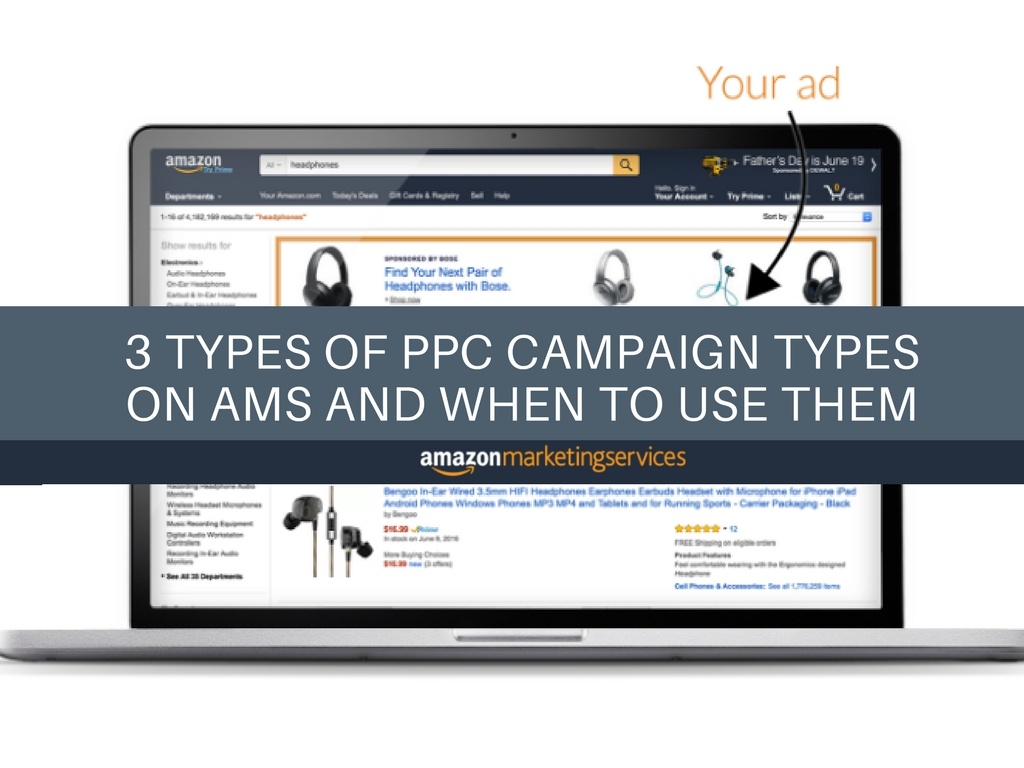Amazon’s Vendor Program comes with perks and downsides. For some brands, selling wholesale directly to Amazon can help to grow revenue and reach new customers with potentially less fuss than on Seller Central. Once you start using Vendor Central you also get access to AMS (Amazon Marketing Services), an advertising platform which offers more advanced paid search placements than Seller Central.
While appealing to brands who want to capitalize on these advanced ad placements, AMS is much more complex than running Sponsored Products campaigns on Seller Central (SC). Users need to master the new campaign types, learn how to include different creative elements in these new ad types, and navigate a difficult-to-understand reporting dashboard. But as with any form of paid search, brands on Vendor Central need to be strategic about their PPC campaigns to make sure they are getting the most bang for their buck.

Choosing the best-suited campaign type
Once you’ve figured out how to setup a campaign (optimizing bids, keywords and ads), you need to figure out which campaign types will work best for your brand. The most strategic way to view the different ad types are related to goals. One brand may be looking to improve organic rankings of strategic keywords for their products. Another brand might be solely focused on improving overall sales.
Having worked with dozens of clients who use Amazon PPC to achieve their goals, we have identified several scenarios where each of these ad types works best. Let’s see some of them below.
Learn more about how to create campaigns for each of these three ad types in our previous blog post.
About Amazon Marketing Services (AMS)
AMS stands for Amazon Marketing Services, and it is a service available for accounts who are available on Vendor Central, or Vendor Express. This service offers targeted pay per click advertising solutions to help Amazon vendors reach new customers and drive sales.
 AMS can be accessed at: ams.amazon.com
AMS can be accessed at: ams.amazon.com
Related: If you’re interested in learning more about using AMS for your brand, enroll here in our free online training course for Vendors.
Dissecting the AMS ad types
The main advantage of AMS is that vendors can use two additional ad types: Headline Search Ads and Product Display Ads. Let’s take a closer look at these types of ads.

Sponsored products ads are keyword targeted cost per click search ads that appear below the search results, on the right-hand side of the search results page AND on product detail pages (sponsored products related to this item section).
Headline search ads are keyword targeted cost per click search ads that appear at the top of the 1st page of search results on desktop and mobile.
Product display ads are product or interest targeted cost per click ads that appear on the related product details page.
1. Headline Search Ads
- These ads help increase visibility and interact with the customer at the very beginning of his purchase process, as they appear at the top of the search results.
- Up to three products can be included, so headline search ads are most effective when you have a palette of compatible, complementary products
- Headline search ads allow you to write your own ad title (with several limitations, like using imperatives such as “the best, No #1, best seller etc.) so you can test different versions of the ad and find the one that converts best.
- They can also be used as a short term solution if your product does not rank well organically. This allows brands to get some paid 1st page exposure, even if they are not ranking well in organic search.

2. Product Display Ads
Product display ads are the only type which are not displayed through keyword targeting, so they come with some benefits which are unique only to them.
One scenario where the product display ads would really come in handy is launching a ‘full frontal attack’ on your competition. Creating different campaigns targeting competitor’s ASINs which illustrate your products benefit over theirs can actively divert customers from your competition.
You can also run product display ads targeting interests, but we’d only recommend this strategy when your target audience’s interests are really specific. For example, you are selling hiking shoes only and are targeting people who like hiking. Targeting by interest is recommended for advertisers who want to grab as many impressions as they can. They usually have a higher ACoS compared to other campaign types.
Related: To learn more about how AMS ads work, read our PPC analysis for AMS VS Seller Central Ads.
3. Sponsored Products
Sponsored Product ads are a great way to get additional sales for vendors who have done their homework and are familiar with their products benefits, their target customer, and the search queries they use. If you manage to get the targeting keywords right, Sponsored Product ads can do wonders for sales.
Getting results
A campaign’s performance depends on a few things: campaign setup (optimizing bids, keywords and ads), the quality and desirability of the product. If you get it right the first time you can get some sales in a matter of days, even the same day in a best case scenario. If your campaigns may look fairly unsuccessful in their first days of running, don’t get discouraged! Sales data lags for up to 72 hours and Amazon suggests leaving the campaign running for a week before making any changes to it.
IF YOU NEED HELP NAVIGATING THE MURKY WATERS OF AMAZON’S VENDOR PROGRAMS OR MASTERING AMAZON MARKETING SERVICES, CONTACT US HERE.
At Bobsled Marketing we work with dozens of brands using the Vendor Express, Vendor Central, and Seller Central platforms. Through our optimized product launch process, daily account management, PPC management, and strategic oversight, we can help you get there faster.
